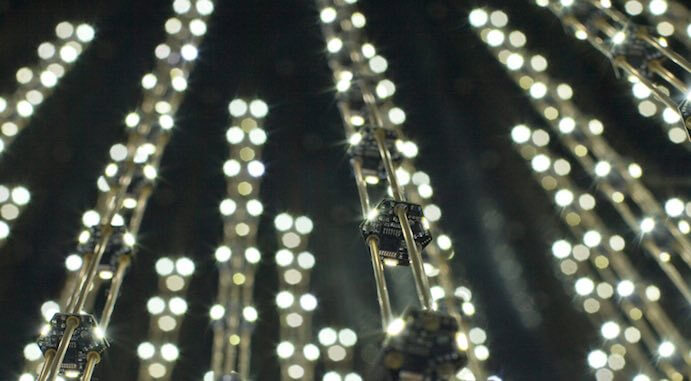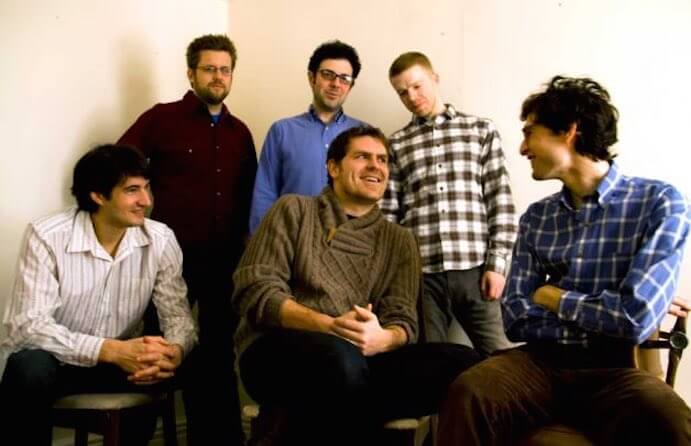It’s no secret that world premieres by early-career composers can often be extremely special events. At many of these performances, the audience is not only witnessing the birth of a new work, but they are also taking part in the development of a fresh musical language and its exposure to the artistic community. It was remarkable, then, when six such composers from the Sleeping Giant Collective—Timo Andres, Robert Honstein, Christopher Cerrone, Andrew Norman, Ted Hearne, and Jacob Cooper—each contributed new compositions for an evening-length work called Hand Eye, which premiered on June 27 as part of the Great Lakes Chamber Music Festival. As if these exciting young composers weren’t enough potential for an incredible evening of music, the works were commissioned by, written for, and performed by eighth blackbird, who are one of the most sought-after chamber ensembles in the country for good reason.
The program was developed after eighth blackbird performed at a fundraiser for the Great Lakes Chamber Music Festival in the building that contains the art collection of Maxine and Stuart Frankel. Amazed by its depth, the members of eighth blackbird began brainstorming ways to create a work that would draw its musical inspiration from the art. Enter the members of Sleeping Giant, who each visited the Frankels’ collection in 2014, chose an artwork that spoke to them, and responded to those works with the compositions that would become Hand Eye. (Photographs work were displayed in the lobby both before the concert and during intermission.) Cerrone, Norman, Hearne, and Cooper commented in the pre-concert conversation that each composer’s contribution to the project could rightfully stand on its own as a distinct response to one artwork, but Hand Eye was intended to be presented with the acknowledged thread of the Frankels’ collection.
From the very first work on the concert, Checkered Shade by Timo Andres, the pieces in Hand Eye displayed their visual influences. Andres’s work, which was inspired by pen-and-ink abstractions by Astrid Bowlby, was constructed to sound as if the music were “zooming out” over time. Short events converge as the piece unfolds, giving way to a stunning chorale. The most rewarding aspect of Checkered Shades was not in the arc created by the work as a whole, however, but instead in Andres’s moment-to-moment development. The ebb and flow between concrete and abstract musical ideas provided an intriguing commentary on the concept of focus, making the final chorale shine in its assuredness.

rAndom International Swarm Light– Photo by David Brooks
Christopher Cerrone’s South Catalina followed, which was inspired by both an interactive sculpture called “Swarm” by rAndom International and Cerrone’s experiences with the brilliance of light while living in Southern California. “Swarm” responds to live sounds with flurries of light, which Cerrone depicted through aggressive piano and percussion music (the sounds) that the other members of eighth blackbird responded to with improvisatory gestures (the lights). South Catalina certainly succeeded in conjuring the notion of light, and did so with the colorful brilliance that has endeared many people to Cerrone’s music.
The final work on the first half was Robert Honstein’s Conduit, which was inspired by another interactive sculpture called “640 by 480” by Zigelbaum and Coelho, which portrays the human body “merging with computational process.” In three movements titled “Touch,” “Pulse,” and “Send,” Honstein depicted the fusion of human and machine by persistent energetic bursts that emulate the repeated gestures through which we communicate with technology, soft and gorgeous lyricism meant to represent the very moment of interaction, and an intense finale that portrays the completion of the data-transfer process. Despite being an undeniably rewarding musical journey, this was the most difficult work to follow conceptually.
Andrew Norman’s Mine, Mime, Meme, a piece inspired by another rAndom International sculpture called “Audience,” opened the second half. In “Audience,” small mirror-like machines turn and follow observers that walk amongst them. Opening with atomistic gestures, Mine, Mime, Meme developed into a chaotic and asynchronous final section through a dialogue between cellist Nicholas Photinos, the figurative viewer, and ensemble, who embodied the machines. Norman’s composition was extraordinary; the timbral landscape was captivating, as if a few new instruments had been added to the ensemble. Even more amazing, this imaginative sound world rarely (if ever) got in the way of Norman’s development and musical arc.

Sleeping Giant Collective
Ted Hearne’s By-By Huey was a response to Robert Arenson’s “Bye Bye Huey P.,” an evocative portrait of Tyrone “Double R” Robinson, who murdered Huey P. Newton, a founder of the Black Panther Party, in 1989. The portrait is particularly stunning in that Robinson’s face is superimposed with a praying mantis, an image meant to evoke the powerful and disturbing notion of a species that eats their own kind. Hearne’s darkly energetic response to the portrait was equally evocative. For much of the work, the piano led the musical development with an unrelenting bass line on muted strings to which the ensemble responded.
Jacob Cooper’s work Cast, which was inspired by Leonardo Drew’s paper casts of commonplace objects, ended the program. Cooper sought to reflect the very nature of a cast, which by definition is missing the original thing from which it was made. Using ideas from the other composers’ works and fragments of his own, he created an aural “cast” around a single vibraphone line. Toward the end of the work, the vibraphone slowly fades, leaving the ensemble without the object from which it was cast. The artistry of this metaphor was equaled by the beauty of Cooper’s writing, down to the very last gesture in which Yvonne Lam, the violinist with eighth blackbird, slowly moved her bow up the fingerboard on a single sustained pitch until it met her left hand.
Hand Eye must have been a monumental project to organize considering the need to coordinate creative conversation with an art gallery, six composers living across the country, and an ensemble as busy as eighth blackbird. Despite this complexity, the premiere had a breathtaking level of professionalism, musicality, and comfort. Before the concert, Andrew Norman commented that one of his favorite things about eighth blackbird is the ownership they take of the works they perform. The ensemble embodied this dedication and command from the first notes to the final bow. Their playing simply could not be praised too highly—it was precise, expressive, technical, engaging, virtuosic, cooperative, and communicative. As an experience, Hand Eye was imaginatively conceived, artfully crafted, and virtuosically executed in every way. eighth blackbird will perform the work several times throughout the United States during their upcoming season and, hopefully, in the many seasons to follow.




















